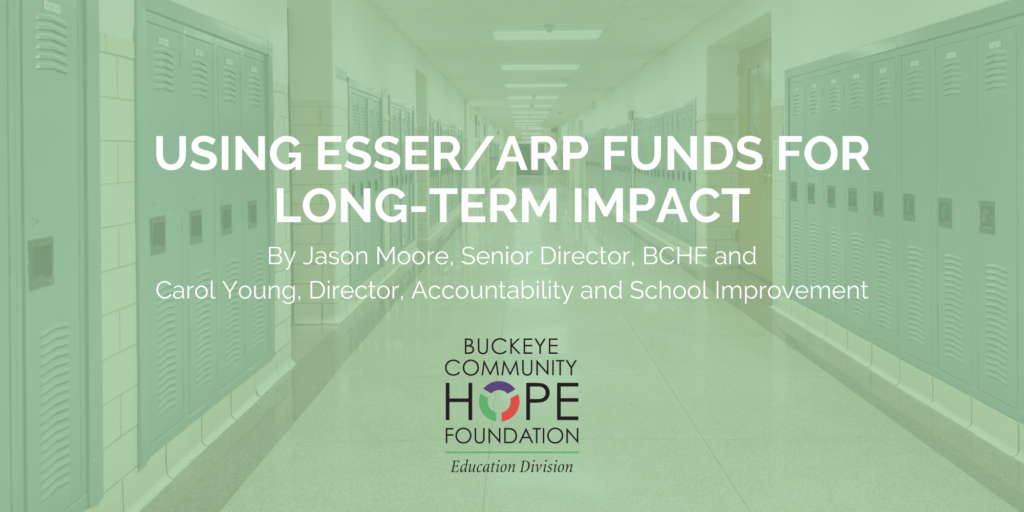By Jason Moore, Senior Director, BCHF and Carol Young, Director, Accountability and School Improvement
As a result of the COVID-19 pandemic and its impact on schools, the federal government sent funding to Ohio to support students through a variety of different funding sources, each with their own timeline. Funding went to Ohio’s Future Forward initiatives at the state level, but most funding went directly to schools. The deadline for the use of the last of these funds, ARP ESSER III, ARP EANS, and ARP Homeless Children and Youth is September 30, 2024. Funds must be expended by this date.
While priorities of ESSER funding programs were to get children back to school, with needed supports, the shift of focus for later ESSER initiatives has been to long-term effects of the pandemic— significant learning loss, educator staffing, and instructional programming to accelerate learning.
Governing boards and school leaders are now in the position of weighing the issue of how BEST to use remaining funds. With a non-renewable funding source, funds must be used wisely and pave the way for a better long-term future for students.
This article aims to share some guidelines to assist schools in their decision making.
Primarily, schools should devote resources to significant areas of need as outlined in your school’s One Plan Needs Assessment. One Plan is part of EdSteps, which requires schools to examine pupil learning data and devote available federal funding to prioritized needs. One Plan reveals the school’s academic performance levels and identifies root causes such as student absenteeism, staffing training and capacity, and evidence-based instructional resources for core instruction and intervention.
Post-pandemic, schools have many common emergent needs. These include the following:
RESPONSE TO THE TEACHER SHORTAGE – The pandemic exacerbated a growing educator shortage in Ohio. ESSER funds may be used to:
- Study and enhance teacher recruitment and retention programs
- Increase teacher and staff compensation. Signing bonuses or other stipends for staff training and extra duties are allowable.
- Improve educator working conditions
- Support the development of an educator pipeline. Funding for training of paraprofessionals or others in “grow your own teachers” programs is allowable.
- Partnerships with universities to fund internships and support training to retain teachers.
For more information on these options, please see: Addressing Teacher and Staff Shortages with ESSER and ARP Funds | Ohio Department of Education and Workforce
LITERACY INITIATIVES – DEW has stated that “ESSER and ARP funds should be used strategically to support accelerated literacy development in kindergarten through grade 12. Local education agencies are encouraged to consider how they can embed evidence-based language and literacy strategies throughout all content areas to support students in accelerating their reading, writing and communication development.” Areas of literacy support for consideration as best use of ESSER funds include:
- Direct student impact programs such as summer learning programs.
- Evidence-based, high-dosage Reading and ELA tutoring programs, and programs for accelerated literacy learning.
- Development of multi-tiered systems of support for student learning, including materials for improving core literacy instruction and literacy intervention.
- Teacher training in the Science of Reading and implementation of high-quality programs may be funded.
In addition, Ohio’s Dyslexia Support Laws went into effect during the pandemic. DEW specifically encourages schools “to use ESSER and ARP dollars to fund the following dyslexia support law requirements:
- Professional development courses for identifying characteristics of dyslexia and understanding the pedagogy for instructing students with dyslexia.
- Courses and training for a multi-sensory certification process for teachers.
- Tier 1 dyslexia screeners to identify students at risk for dyslexia; and
- Tier 2 dyslexia screeners for students at-risk for dyslexia with no progress observed during the monitoring period.”
Schools should also consider if special education personnel are resourced and adequately trained to use appropriate diagnostic tools in the Evaluation Team Report (ETR) process to differentially identify dyslexia as a component of a disability. For more information about using funds for literacy initiatives, please review information at: Supporting Local Literacy Efforts with ESSER and ARP Funds | Ohio Department of Education and Workforce
MATHEMATICS IMPROVEMENT – Student learning of mathematics was the hardest-hit academic area of the pandemic. DEW has supported specialized mathematics tutoring through its ESSER/ARP funding this year, and the Department is in the process of preparing a statewide mathematics plan. Accordingly, schools should plan for significant, high-yield improvement efforts in math including:
- Acquisition of evidence-based instructional programs and materials.
- Teacher professional development.
- Specialized tutoring and summer school, along with multi-tiered intervention plans and resources.
*The need to build teacher capacity in effective mathematics instruction is a high priority in all BCHF schools.
Based on their individual data and plans, schools may also target ESSER funding for support of Workforce Development Initiatives, Wellness Programs, Services for Homeless Students, Positive School Climate, Mental Health and Prevention Education, and Young Learner Initiatives. (See topics at: Search Results | Ohio Department of Education and Workforce)
ESSER/ARP are intended to address student needs and long-range solutions to aspects of schooling impacted by the pandemic. As this funding phases out, governing boards and school leaders should carefully consider long-term needs and how these funds can have the greatest impact. To provide transparency for the public, each school should update, where needed, its Local Use of Funds plan related to ESSER/ARP funding. For more information or technical assistance in developing school plans, please feel free to reach out to your BCHF representative.

